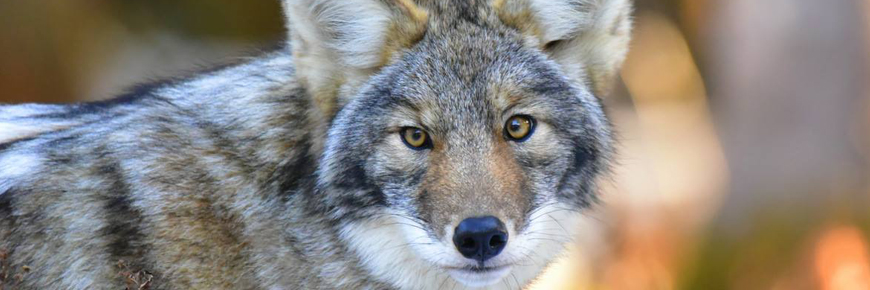
Eastern coyote
Cape Breton Highlands National Park
The eastern coyote looks like a medium-sized German shepherd but is grey or reddish grey with a whitish throat and belly. It is mostly nocturnal although it may be seen at any time of day. The coyote is an opportunistic feeder with its main diet consisting of snowshoe hare, white-tailed deer and rodents. Most of the white tailed deer they eat can be attributed to carrion and hunter kills, although packs of coyotes have been known to take down weakened and sick deer in the winter. Coyotes also eat berries and grasses when available.
The female coyote gives birth to a litter of five to ten pups in April or May. Both male and female hunt and care for the young, sometimes assisted by offspring from previous years. Coyotes exhibit a high degree of monogamy and may mate for life. A coyote may live up to 18 years in the wild, but on average probably lives only about nine years.
Distribution
Coyotes can be found over most of North America, from Alaska down south to Mexico and from the prairies east to southern Ontario and Québec, and the Atlantic Provinces.
Our eastern coyote
The coyote migrated to Nova Scotia in the late 1970s and was in Cape Breton Highlands National Park by 1981. This movement was part of a natural range expansion. As wolves were wiped out across most of eastern North America coyotes moved east and north. In the early 20th century coyotes interbred with wolves in Ontario and Québec and as they continued to move east, this genetic heritage has remained . This has resulted in coyotes that are larger and more robust then their western ancestors. Studies in Cape Breton have shown that our coyotes are genetically very similar to those found in other areas of eastern North America—they have wolf DNA.
Although it is a fairly large carnivore and sometimes hunts in packs, coyotes have not filled the shoes of the wolf as a predator. Coyotes hunt and prey on white tailed deer but the abundant moose population of Cape Breton Highlands National Park is not regulated by coyotes. Research in Northern Cape Breton has shown that moose is an important food item for coyotes but its unknown how many moose they stalk and kill and how many are scavenged as a result of other mortality factors. Besides moose and deer, coyotes eat snowshoes hare and rodents—they also eat all types of fruit but blueberries are their favourite.
Coyotes are a very adaptable, curious and intelligent animal. They have learned to live close to and around humans. In Cape Breton Highlands National Park coyotes have occasionally become accustomed to the presence of people. This has resulted in some animals being relatively fearless. This does not mean they are aggressive or starving. However coyotes are wild animals and care and caution is needed when they are close. Do not approach or feed coyotes, watch them from a distance. For information on coyotes and your safety, see Coyotes and public safety.
Related links
- Date modified :